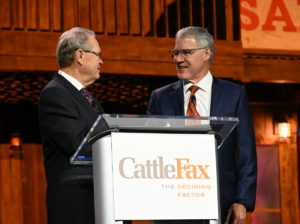 The popular CattleFax Outlook Seminar, held as part of CattleCon 2025 in San Antonio, Texas, shared expert market and weather analysis. Pictured are Jerry Adams, CattleFax President who is shown giving Randy Blach, CEO, CattleFax some recognition for his many years of service.
The popular CattleFax Outlook Seminar, held as part of CattleCon 2025 in San Antonio, Texas, shared expert market and weather analysis. Pictured are Jerry Adams, CattleFax President who is shown giving Randy Blach, CEO, CattleFax some recognition for his many years of service.
Here are some excerpts and their remarks on stage. I’m starting with Matt Makens, Meteorologist / Atmospheric Scientist at Makens Weather LLC.
Weather conditions will remain a critical factor influencing grazing availability, herd expansion and cattle prices. Meteorologist Matt Makens said La Niña this winter brings rather volatile weather changes across North America with the majority of weather extremes affecting those in the Central to Eastern U.S. For Mexico and the Southwestern U.S., producers will see drought acreage increase as it has nationwide since June.
“Drought will likely increase across the Western U.S. this spring and into the Pacific Northwest, Northern Plains, and Canadian Prairies through this summer. To watch will be the North American monsoon and how much drought relief it can provide to Mexico, the Southwest, and parts of the Plains,” he said. “Current data show the monsoon is likely to produce more moisture this year than last. A strong enough monsoon can decrease precipitation across the central Corn Belt, watch July closely. Late in the year, the focus turns to the development of La Niña or El Niño.”
Listen to his remarks here:
Matt Makens presentation (20:56)
Next is Kevin Good, vice president of market analysis at CattleFax. He reported that U.S. beef cow herd is expected to see the cycle low to start 2025 at 28 million head, 150,000 head below last year and 3.5 million head from the 2019 cycle highs.
“We expect cow and bull slaughter to continue declining in 2025, with overall numbers down by about 300,000 head to 5.9 million head total. Feeder cattle and calf supplies outside of feedyards will also shrink by roughly 150,000 head, while cattle on feed inventories are starting the year slightly below 2024 levels at 11.9 million head,” he said. “With a tighter feeder cattle supply, placement pace will be more constrained, leading to a projected 700,000-head drop in commercial fed slaughter to 24.9 million. After modest growth in 2024, beef production is expected to decline by about 600 million pounds to 26.3 billion in 2025, ultimately reducing net beef supply per person by 0.8 pounds.”
Beef prices continued their upward trend in 2024, averaging $8.01/lb., the second-highest demand level in history. While demand may ease slightly in 2025, retail prices are still expected to rise to an average of $8.25/lb. Wholesale prices will follow suit, with the cutout price projected to reach $320/cwt.
Listen to his remarks here:
Kevin Good presentation (22:54)
Concluding the session is Randy Blach, CattleFax chief executive officer.
He has an overall positive outlook, and noted that strong margins in the cow-calf sector have set the stage for cowherd expansion to begin, with heifer retention likely back near a more normal pace, relative to minimal retention in recent years. Drought and pasture conditions are now the key factors influencing the rate of expansion with a slower herd rebuild anticipated compared to the last cycle. This more measured expansion pace implies a positive outlook for producer returns over the next several years. Strong consumer demand also remains a bright spot for the industry.
“We have to remember where we came from,” Blach said. “Continued improvements in quality and meeting consumer expectations with a safe, nutritious product and a consistently good eating experience have had tremendous impacts on moving the needle for this industry. We’re moving in the right direction, and we need to keep paying attention to that signal.”
Listen to his remarks here:
Randy Blach presentation (17:25)
